Audiovox FRS-3000PK User manual
- Category
- Two-way radios
- Type
- User manual
This manual is also suitable for

128-6476
1 of 28
Released: 9-6-02.
GenerGener
GenerGener
Gener
al Mobile Radio Seral Mobile Radio Ser
al Mobile Radio Seral Mobile Radio Ser
al Mobile Radio Ser
vice (GMRS)vice (GMRS)
vice (GMRS)vice (GMRS)
vice (GMRS)
Model:Model:
Model:Model:
Model:
GMRS-3000PK GMRS-3000PK
GMRS-3000PK GMRS-3000PK
GMRS-3000PK
RecharRechar
RecharRechar
Rechar
gg
gg
g
eaea
eaea
ea
ble GMRS Handset Tble GMRS Handset T
ble GMRS Handset Tble GMRS Handset T
ble GMRS Handset T
rr
rr
r
ansceivansceiv
ansceivansceiv
ansceiv
er ander and
er ander and
er and
Base SBase S
Base SBase S
Base S
tt
tt
t
ation Tation T
ation Tation T
ation T
rr
rr
r
ansceivansceiv
ansceivansceiv
ansceiv
er Wer W
er Wer W
er W
itit
itit
it
h Nh N
h Nh N
h N
OO
OO
O
AA
AA
A
A WA W
A WA W
A W
eateat
eateat
eat
herher
herher
her
AlerAler
AlerAler
Aler
tt
tt
t
OwnerOwner
OwnerOwner
Owner
’s Man’s Man
’s Man’s Man
’s Man
ualual
ualual
ual
Customer Service
1-800-290-6650
© 2002 Audiovox Electronics Corp., Hauppauge, NY 11788

128-6476
2 of 28
2
NEVER ATTEMPT TO CHARGE ALKALINE OR DRY CELL BATTERIES, AS
BATTERIES MAY BURST CAUSING PERSONAL INJURY AND DAMAGE
TO THE PRODUCT. WHEN RECHARGING NICKEL METAL HYDRIDE
(NiMH) BATTERIES WITH THE SUPPLIED AUDIOVOX CHARGER AND
WALL ADAPTER, USE ONLY AUDIOVOX-APPROVED RECHARGEABLE
BATTERIES. USE OF THE AUDIOVOX CHARGER WITH OTHER BRANDS
OF BATTERIES IS NOT RECOMMENDED, AS BATTERY CHARGING TIMES
WILL VARY WITH DIFFERENT BRANDS. REFER TO THE
MANUFACTURER’S INSTRUCTIONS FOR CHARGING OTHER BRANDS
OF BATTERIES.
AVOID PLACING THE GMRS-3000PK RADIO TRANSCEIVER FOR PRO-
LONGED PERIODS OF TIME IN DIRECT SUNLIGHT OR TEMPERATURES
BELOW -4° F (-20° C) OR ABOVE 140 ° F (60° C).
KEEP THE ANTENNA AT 1 INCH (2.5 cm) AWAY FROM YOUR HEAD AND
BODY. DO NOT USE YOUR GMRS-3000PK RADIO TRANSCEIVER WITH
A DAMAGED ANTENNA.
PLACE THE RUBBER COVERS ON JACKS WHEN NOT IN USE.
GMRS LICENSE:
USE OF THIS RADIO WITHIN THE UNITED STATES REQUIRES AN FCC
GMRS LICENSE. AN INDIVIDUAL 18 YEARS OF AGE OR OLDER, WHO IS
NOT A REPRESENTATAIVE OF A FOREIGN GOVERNMENT, IS ELIGIBLE
TO APPLY FOR A GMRS SYSTEM LICENSE. YOU WILL NEED TWO FORMS
FROM THE FCC; FCC FORM 159 AND FCC FORM 605 MAIN FORM AND
SCHEDULE F. YOU CAN FIND THE FORMS ONLINE AT:
HTTP://WWW.FCC.GOV/FORMPAGE.HTML, OR CALL 1-800-418-3676.
COMPLIANCE:
This transceiver complies with FCC regulations for use in the United
States of America. Use in other countries may be prohibited or restricted
by local regulation. Please check with the local regulating agency be-
fore using this device outside the United States of America.
CAUTION

128-6476
3 of 28
3
GMRS-3000PK Handset and Base Station Transceivers
The handset transceiver, when equipped with NiMH rechargable batteries,
can be recharged when placed in the fixed base station transceiver cradle,
which also acts as a desk-top charger.
BASE STATION
RETRACTABLE
ANTENNA
HANDSET
TRANSCEIVER
ANTENNA
HANDSET
RECHARGABLE
TRANSCEIVER
FIXED BASE
STATION
TRANSCEIVER
AC WALL ADAPTER
120 VAC TO 9 VDC
(P/N F30ADP)
WALL ADAPTER
OUTPUT PLUG
(9 VDC)
BASE STATION
INPUT JACK
(DC 9V)

128-6476
4 of 28
4
1. Battery Door
2. Monitor/Backlight Button
3. Detachable Carry Clip
4. Push-To-Talk (PTT) Button
5. Antenna
6. External Speaker(SPK)/Micro-
phone (MIC) Jacks
7. Liquid Crystal Display (LCD)
8. Combination Transmit Indi-
cator (Red)/Receive and Moni-
tor Indicator (Green)
GMRS-3000PK Handset Controls and Indicators
9. SCAN/Lock Button
10. Up Channel/Volume Button
11. Emergency (EMG) Call Button
12. Built-in Microphone
13. Built-in Speaker
14. Down Channel/Volume
Button
15. Power On/Off Control
16. MODE Button
17. Battery Charging Contacts
3
5
4
1
2
6
9
14
11
8
10
13
7
17
15
5
(REF)
3
(REF)
16
12
1
(REF)

128-6476
5 of 28
1. Handset Battery Charge
Contacts
2. Built-in Speaker
3. Up/Down Channel/Volume
Buttons
4. MODE Button
5. Antenna
6. Combination Transmit Indicator
(Red)/Receive and Monitor Indica
tor (Green)/Backlighting (Red/
Green)
7. DC 9V Charger Input Jack
8. Liquid Crystal Display (LCD)
GMRS-3000PK Base Unit Controls and Indicators
9. Battery Charge LED (Red)
10.
Power On/Off and Function
Set Button
11. SCAN/Lock Button
12. Emergency (EMG) and
Monitor (M)/Backlight Button
13. Handset Battery CHG Button
14. Push-To-Talk (PTT) Button
15. Built-in Microphone
16. External Microphone (MIC)
Jack
17. External Headset/Speaker
(SPK) Jack
5
6
15
5
4
10
11
2
9
7
12
14
13
1
3
8
+
DC 9V
16
17

128-6476
6 of 28
6
GMRS-3000PK Handset and Base Station Displays
1. Beep Tone Indicator: Icon appears when beep confirmation tone is
selected; icon disappears when tone is off.
2. Monitor Indicator: Icon appears when the Monitor (M) button is
pressed and the channel monitor function is activated.
3. Key Lock Indicator: Icon appears when the keypad is locked. This
function disables keys such as channel up/down and MODE.
4. Signal Strength Indicator: Icon appears when a signal is being
received. The icon consists of five bars to indicate the received signal
level.
5. Continuous Tone Coded Squelch System (CTCSS) Indicator:
Indicator appears when the CTCSS tone function is active.
6. Large Segment Display: Indicates the GMRS/FRS channel number
in use.
7. Scan Indicator: This indicator appears when the scan function is
active to scan a channel every 0.5 second.
8. Dual Watch Mode Indicator: Indicator appears when dual watch mode
is active.
9. RogerBeep Tone On/Off Indicator: This icon appears when the
Roger Beep tone is on, and disappears when tone is not in use.
10
11
12
8
9
7
6
4
5
3
2
1
13
14
15
16
17

128-6476
7 of 28
7
10. Battery Level Indicator: Icon indicates the battery charge level.
11. Emergency (EMG) Indicator: EMG icon appears when the EMG/M
button pressed. (The emergency frequency is not monitored by
authorities.)
12. Weather Mode Indicator (Base Station Only): This icon appears
steady on the Base Station display when the weather mode is active;
it flashes when weather alert is active in the GMRS mode.
13.Power HI/LO Indicators: Appropriate icon appears when the transmit
power is set to desired output power on the GMRS channels only.
14.Caller Identification (ID) Indicator: This indication appears when
you select a caller identification code (between 1 and 10). ID selection
operates in conjunction with the small segment display, and can also
be used to identify a calling party in the monitor mode.
15.Small Segment Display: Displays the CTCSS tone option in the
channel from (01-38).
16.Out of Range Indicator: Icon flashes when signal strength becomes
weak and intermittant.
17. Voice Activated Transmission (VOX) Indicator: The indicator appears
when the VOX mode is activated.

128-6476
8 of 28
Powering the Transceivers:
Your GMRS-3000PK handset transceiver operates on four AAA batteries.
Alkaline batteries will provide slightly better performance than the supplied
rechargeable batteries. Only Audiovox approved rechargeable batteries
can be recharged in the handset transceiver using the Base Station
charging feature and the Wall Charging Adapter supplied with the unit.
This will ensure optimum performance for the GMRS-3000PK. Use of the
Base Unit charging feature with other brands of batteries is not
recommended as battery charging times will vary. Refer to the
manufacturer’s instructions for charging other brands of batteries.
Equipment and Accessories Supplied
1.Radio Transceivers (2) GMRS-3000PK (Handset and
Fixed Base Station)
2.Owner’s Manual (1) 128-6476
3.Batteries (4) Rechargeable NiMH (P/N
F30BATT)
4.AC Wall Adapter (P/N F30ADP)
Batteries
There are three methods of powering the GMRS-3000PK Handset Trans-
ceiver:
1. Alkaline Batteries.
WARNING: Do not attempt to recharge Alkaline batteries. Also, make
sure to turn off the charger feature of the base station
when rechargeable batteries are not being used.
2. Audiovox Rechargeable NiMH Batteries - (Rechargeable NiMH
batteries, Base Station Transceiver, and Wall Charging Adapter
included as part of the GMRS-3000PK). Use only Audiovox approved
rechargeable batteries and Base Station charger when charging
batteries internal to the Handset Transceiver.
8

128-6476
9 of 28
9
3. Various Brands of Rechargeable Batteries - Use of the Base
Station charging feature with other brands of rechargeable batteries
is not recommended, as battery charging times will vary with differ-
ent brands of batteries. Refer to the manufacturer’s instructions for
charging other brands of batteries.
The battery charge indicator icon displays the battery charge level in the
handset transceiver. When the AC adapter is connected to the base station
transceiver, it’s indicator icon will always indicate a full charge when the
base station is powered on. A full charge of batteries in the handset
transceiver is indicated by the battery icon as shown below:
Full Battery - three segments are illuminated.
Low Battery - one segment is illuminated.
Approximately 10-12 hours are required to fully charge the batteries in the
handset transceiver. The red H LED charging indicator (9) on the base
station transceiver will light whenever the batteries are charging. If the
charging indicator flashes on/off momentarily when the CHG button is
pressed to on, it is likely no batteries are installed in the handset unit. You
must set the CHG button off when using any batteries other than the ones
provided for the handset transceiver. Failure to do this may cause damage
to the batteries resulting in personal injury and/or damage to either, or
both, transceivers.
Caution: The charging adapter is intended for use with the supplied
rechargeable NiMH batteries, Part Number F30BATT. Do not
attempt to recharge any other type batteries.
Installing the Batteries in the Mobile Transceiver
Battery installation in the Mobile Transceiver is made more convenient
when the carry clip is removed. To do this, release the spring latch securing
the clip to radio and slide the clip downward and away from the radio body.

128-6476
10 of 28
10
The following guidelines will improve performance and provide longer
operating times for the GMRS-3000PK handset transceiver:
1. Do not mix old and new batteries.
2. The use of alkaline-type batteries is recommended to provide the
longest operating time.
3. Do not mix alkaline, standard (carbon-zinc) or rechargeable
batteries.
4. If the unit is not to be used for an extended period of time, remove
the batteries. Old or leaking batteries can cause damage to the unit
and will void the warranty.
2. Then lift up cover at
bottom to open. Then
remove cover from
unit.
3. Insert four AAA batteries
(positive (+) end toward
the bottom begining at
left side and alternating
positive terminals as
shown).
1. Using thumb,
press down on
battery cover at
arrow and slide
cover down.
Next, press down with the thumb at the embossed arrow on the battery
compartment cover, and slide the battery cover down and off the radio.
Insert four AAA batteries (alternate positive ends (+) toward the bottom of
the transceiver, (starting left-to-right).
SPRING
LATCH
BATTERY
COVER
CARRY
CLIP
COVER
ARROW
POSITIVE
TERMINALS
+ +
+ +

128-6476
11 of 28
11
Base Station Transceiver Charging Setup For the Handset Transceiver
When the handset transceiver is equipped with rechargeable NiMH batter-
ies (supplied), they may be charged using the base station setup as fol-
lows:
1. Position the handset transceiver in the base station cradle as shown.
2. Connect the charging adapter plug to the DC 9V jack at the rear of the
base station transceiver.
3. Plug the other end of the charging adapter into a 120 VAC outlet.
4. Apply power to the base station; then momentarily press the CHG but-
ton. The H indicator lights red indicating the handset transceiver batter-
ies are being charged.
5. To terminate battery charge, remove the handset from the cradle or mo-
mentarily press the CHG button again; the H indicator will extinguish.
HANDSET
TRANSCEIVER
EQUIPPED WITH
RECHARGEABLE
BATTERIES
CHARGING ADAPTER
PLUG
CHARGING (H)
LED INDICATOR
CHARGE (CHG)
ON/OFF BUTTON
AC WALL
CHARGING
ADAPTER
BASE STATION WITH
CHARGING FEATURE
MODEL (P/N F30ADP)
INPUT: 120 VAC
OUTPUT: 9 VDC

128-6476
12 of 28
Controls:
Power On/Off Button
Press and hold the power on/off button (
) for at least 2 seconds. You
will hear a confirming melody to indicate the unit is on. To turn the unit
off, press and hold the button for at least 2 seconds.
Adjusting the Volume
With either transceiver powered on, press the respective Up
Channel/Volume button (
) to increase volume and the Down
12
GMRS-3000PK OPERATIONAL MODES
NOTE: The Mode Control features for
both the Handset transceiver
and the fixed base station
transceiver are the same, except
the base station also has a
Weather Station Alert (NOAA)
capability, plus it can charge the
Handset batteries when this unit
is equipped with Audiovox ap-
proved rechargeable batteries.
CALL
SELECT
BUTTON
BEEP
ROGER
BEEP
DUAL
WATCH
POWER
SELECT
I D
SELECT
HANDSET & BASE
STATION MODE
CHANNEL
SELECT
CTCSS
SELECT
VOX
SELECT
GMRS Channels
Only
WEATHERBAND
ALERT
CHANNEL
SELECT
BASE STATION
WEATHER MODE
Press and Hold
MODE Button

128-6476
13 of 28
13
Channel/Volume button ( ) to decrease volume. The display will indicate
the current volume level between 1 and 7 by the small number in the icon
( U
05
).
Monitor/Display Backlight Button
This button is used to check activity on the current frequency before
transmitting. Check activity by pressing the Monitor (M) Button longer
than 2 seconds; the
icon will apppear on the display and you will
hear static if frequency is clear. Do not transmit if you hear conversation.
Hold down the Monitor Button again longer than 2 seconds and the
icon will disapppear from the display.
The monitor function will temporarily bypass the squelch setting and play
all signals on a given channel. This feature is useful when communicating
with other parties at extreme range.
By pressing the monitor button momentarily, the green monitor LED (left
side) and red LCD backlight (right side) are both turned on accompanied
by a beep tone; both LEDs will turn off automatically in about 5 seconds, or
when the monitor button is pressed momentarily once again.
Push To Talk (PTT) Button
Pressing and holding this button will allow you to speak to any transceiver
that is set to the same channel and privacy code setting as yours. Hold the
transceiver approximately 1 to 2 inches from your face as you speak into
the built in microphone . After you have finished speaking, release the PTT
Button to allow reception of incoming signals. It is not possible to transmit
and receive at the same time. The Transmit/Monitor LED at the upper
inside right corner of the LCD Panel will light red while the PTT Button is
pressed.
Releasing the button allows the unit to revert to standby mode. When
receiving an incoming signal, the Transmit/Monitor indicator at the upper
inside left corner of the LCD panel will light green, and the received signal
strength indicator (
) will display the relative strength of the signal.
The PTT Button can also be used as a two-way call ringer. Pressing the
button twice quickly will call another party on the same channel. The call
ring melody will sound on the receiving unit for approximately 3 seconds.

128-6476
14 of 28
14
Up Channel/Volume Button
In the standby mode, pressing this button will increment the listening
volume. When in function edit mode this button will be used to adjust the
unit’s settings.
Down Channel/Volume Button
In the standby mode, pressing this button will decrement the listening
volume. When in function edit mode this button will be used to adjust the
unit’s settings.
Mode Button
This button is used to select the various feature settings such as channel/
CTCSS code selection, VOX mode, etc.
External Speaker (SPK)/Microphone (MIC) Jacks
These jacks, one on the handset (6), and two on the base station (16,17)
accept an external Audiovox headset/microphone connector (optional
accessory). For additional optional equipment and accessories for the
GMRS-3000PK, visit the Audiovox web site at www.audiovox.com.
Scan/Lock Button
Press this Button momentarily to enable or disable the scan mode. Press
and hold the button for more than 1 second to lock or unlock the key pad. All
buttons will be active in the lock mode except, MODE and SCAN. When the
keypad is locked, the (
) icon will display in the top left corner.
Operating Modes and Features
GMRS/FRS Operation:
- From the GMRS/FRS standby mode, press and hold the ( ) button
for 2 seconds to turn on power.
- Press the MODE button so the Channel number flashes.
- Select the desired channel with the Up and Down Buttons. When
receiving a call, the Monitor LED lights green, and the signal strength
meter, consisting of a 5-bar graph, is displayed and indicates in-
coming received signal strength from minimum (a single bar) to
maximum (five bars).

128-6476
15 of 28
15
- Press and hold the PTT button to transmit, then speak into the
microphone clearly and slowly. The Transmit LED lights red.
- Release the PTT Button to receive.
- Communication can only be accomplished when the channel and
CTCSS tone frequency of at least two parties are the same.
- The CTC icon will be displayed on the LCD panel if the CTCSS tone
frequency function is enabled.
Channel Selection
In order to communicate with other FRS units, both transmitting and re-
ceiving party must be on the same frequency.
The GMRS-3000PK has 22 channels (frequencies) indicated by the large
digits on the LCD display panel. Channels 1-7 are shared GMRS/FRS
channels; channels 8-14 are FRS only channels, while channels 15-22
are assigned GMRS only channels. If an FRS only channel (8-14) has
been selected, the HI or LO icon will not be displayed on the LCD panel;
otherwise, for channels 1-7 (GMRS/FRS) and 15-22 (GMRS only), the HI or
LO icon will be displayed. Communication with Audiovox GMRS/FRS and
compatible units is possible on these 22 channels. Before transmitting on
the selected channel, press the Monitor (M) Button to check the activity on
that channel. If there is activity on the selected channel, change to another
channel that is clear.
To change the channel:
- From GMRS/FRS standby mode, press the MODE button
once, or until the channel number flashes.
- Press the Up Button briefly to move to the next higher main
channel number.
- Press the Down Button briefly to move to the next lower main
channel number.
CTCSS Mode (Sub-Channel) Selection
The Coded Tone Controlled Squelch System (CTCSS) provides 38 Sub-Fre-
quencies. This feature allows you to utilize the coded squelch tones
(01–38) within a main channel and enables you to communicate with

128-6476
16 of 28
16
another party on the same main channel using the same subcode. (This
filters out unwanted transmissions without the same coded squelch tone).
There are 38 CTCSS Sub-channels for each main channel. A different
subcode may be selected for each of the 14 channels.
To change the CTCSS Sub-channel:
- From GMRS/FRS standby mode, press the MODE Button twice; a
flashing oF or sub-channel number is displayed, together with the
flashing CTC icon. If oF is displayed, press the Up or Down button to
enable the CTCSS mode; the CTC icon will also flash on the display
with the flashing sub-channel number.
- Then press the Up or Down button to select the desired sub-channel
for use.
- Press the PTT button momentarily to confirm selection.
The CTCSS mode can be turned off by selecting the oF icon as the setting.
NOTE: To communicate with other FRS units, they must be switched to
the same channel and CTCSS subcode. To communicate with
other FRS units that do not have subcodes, switch your unit to
the same channel with the subcode set to oF.
The CTCSS subcodes do not prevent others from hearing your
transmission. This will only allow you to ignore all traffic on a
given channel not using the same subcode.
Transmit Power Selection Mode
This feature permits selection of the transmitting power level to high
or low on the GMRS channels. (FRS only channels 8-14 automatically
operate on low power only.) Using low power, the unit will have a
lower transmit range, but battery life will be increased.
NOTE: You will find that for the majority of your needs, the low-power
setting will provide adequate communications on all channels;
there should seldom be any need to use high power, except in
situations where you need absolute maximum range. Using low
power will greatly extend battery life. We suggest you experi-
ment with switching between low and high power. However,

128-6476
17 of 28
17
we do recommend that you not change this setting unless it
proves to be necessary in your particular situation.
To access the transmitter power selection function, the selected channel
must be either GMRS/FRS (1-7) or GMRS only (15-22). Select the desired
power as follows:
- From GMRS/FRS standby mode, press the MODE Button 3 times
until the Po HI or Lo indication appears with a flashing HI or LO indica-
tion on the display.
NOTE: If the current channel is FRS only (8-14), power will not be
selectable.
- Press the Up or Down button to toggle between the High and Low se-
lections.
- Press the PTT button momentarily to confirm selection.
VOX Selection Mode
This option enables you to have hands-free conversation. Your voice or
nearby sound is detected and the radio transmits without the need to
press the PTT button.
To set radio for VOX operation:
- From GMRS/FRS standby mode, press the MODE button 4 times until
Uo appears with the VOX icon flashing on the display.
- Press the Up or Down button to select VOX On (if oF appears flash-
ing) and the 1-5 VOX level sensitivity.
- Momentarily press the PTT button to confirm the VOX selection.
- The VOX icon will appear steady on the LCD display.
A VOX sensitivity of 1 is the most sensitive, and should be used in a rela-
tively quiet surrounding. A VOX sensitivity of 5 is the least sensitive and
should be used in a noisy surrounding.
VOX can be turned off by selecting oF as the setting.
Dual Watch Mode
This feature allows you to monitor two channels at the same time. While in
dual watch mode, the unit will continuously monitor both the primary and
dual watch channel. Received signals will be played for 5 seconds, then

128-6476
18 of 28
18
the unit will resume scanning the two channels. Pressing the PTT button
during a received transmission will set the unit to transmit on the same
channel. Pressing the PTT button when no signal is received will set the
unit to transmit on the primary channel.
To set the Dual Watch Mode:
- From GMRS/FRS standby mode, press the MODE button 5 times; dc
appears on the display with the flashing DW icon. If the dual watch
mode is off, the oF icon will also appear flashing.
- To enable the dual watch mode, press the Up or Down button; the dual
watch channel number will flash and start to increment up or down as
the Up or Down button is pressed.
- Press the PTT button to confirm selection of the dual watch
channel. The display will now alternate between the primary channel
and the dual watch channel just selected.
Roger Beep Tone
The Roger Beep is a tone which is automatically transmitted whenever the
PTT button is released. This tone alerts the receiving party that the trans-
mission has been terminated intentionally.
To enable and disable the Roger Beep tone:
- From GMRS/FRS standby mode, press the MODE Button 6 times until
rb appears on the display with the flashing Roger Beep icon (
) and
On or oF.
- Press the Up or Down Button to select the tone on or off as desired.
- When enabled, the tone icon (
) appears steady on the display.
- Press the PTT button momentarily to confirm selection.
Key Tone
This feature allows the transceiver to sound a confirmation tone whenever
the following keys are pressed: Monitor (M) Button, Up/Down Buttons, MODE
Button or the SCAN Button.
To turn the key tones on or off:
- From GMRS/FRS standby mode, press the MODE Button 7 times until
bP, the Bell (
) icon, and On or oF flash on the LCD display.

128-6476
19 of 28
19
- Press the Up or Down Button to toggle the key tone feature On or Off.
- Press the PTT button momentarily to confirm selection.
When the key tone feature is on, the Bell icon appears steady on the
display, and the beep tones sound in response to button activation.
Caller Identification (ID) Select
The caller ID function allows you to assign an ID code between 1 and 10;
this code accompanies your transmission whenever you call another party,
and will appear at the receiving unit, provided it has caller ID capability.
To select a caller ID code for your unit:
- From GMRS/FRS standby mode, press the MODE button 8 times; Id
appears, together with a flashing ID and number (or oF) indication.
- If oF appears, press the Up or Down Button to select the desired caller
identification code for your unit between 1 and 10.
- Press the PTT button momentarily to confirm selection.
Now, your caller ID number will accompany each call transmission, and
will appear on the receiving unit, if so equipped, and vice-versa.
Call Ringer Selection Mode
The transceiver provides 3 user-selectable call ringer melodies to alert
you to an incoming call.
To select your call ringer melody:
- From GMRS/FRS standby mode, press the MODE button 9 times;
C will appear on the display, together with a flashing number (or oF)
between 01 and 03, and an appropriate call ring.
- Press the Up or Down Button to preview and hear the 3 available call
melodies.
- Press the PTT button momentarily to confirm selection.
Refer to the PTT button (4) to transmit ring signal.
Channel Scan Operation
This feature allows you to monitor all channels automatically for activity.
While scanning, you can transmit and receive. When a signal is received,

128-6476
20 of 28
20
the scan is interrupted and will return to scan mode 5 seconds after recep-
tion is terminated.
NOTE: While the scan function is active, the MODE button will be
inoperative. The scan mode will reduce the overall battery life
since the battery save function is overridden.
To enable the channel scan mode:
- From GMRS/FRS standby mode, momentarily press the SCAN But
ton; (SCAN) will appear on the LCD display.
- The radio will display each channel (1-22) in order as the scan mode
operates to find an active main channel.
- If the unit doesn’t find any signals and you want to transmit, press the
PTT switch to return to home channel operation. The transceiver will
automatically resume scanning approximately 5 seconds after the
communication is completed.
- If there is no activity and you want to leave the scan mode, press the
SCAN button momentarily and the unit will return to normal operation;
SCAN icon will disappear from the LCD display.
Emergency and Assistance Channel Mode
This radio has a quick access button (EMG/M) to the Emergency and
Assistance Channel. This channel is not monitored by local authorities.
When using this channel, EMG appears on the display. Pressing this
button will set the transceiver to the channel 20, 462.6750 MHz).
The Emergency Channel can be selected quickly from any user mode.
To access the Emergency Channel mode:
- Press Emergency (EMG) Button; EMG and Channel 20 appears on
the display.
- To turn off the Emergency Channel feature, press and release the
EMG Button.
Auto Key Lock Selection Mode
This feature prevents accidental or unintentional change to the preferred
settings of the unit. The Auto Key Lock function temporarily disables the
MODE and SCAN Buttons.
Page is loading ...
Page is loading ...
Page is loading ...
Page is loading ...
Page is loading ...
Page is loading ...
Page is loading ...
Page is loading ...
-
 1
1
-
 2
2
-
 3
3
-
 4
4
-
 5
5
-
 6
6
-
 7
7
-
 8
8
-
 9
9
-
 10
10
-
 11
11
-
 12
12
-
 13
13
-
 14
14
-
 15
15
-
 16
16
-
 17
17
-
 18
18
-
 19
19
-
 20
20
-
 21
21
-
 22
22
-
 23
23
-
 24
24
-
 25
25
-
 26
26
-
 27
27
-
 28
28
Audiovox FRS-3000PK User manual
- Category
- Two-way radios
- Type
- User manual
- This manual is also suitable for
Ask a question and I''ll find the answer in the document
Finding information in a document is now easier with AI
Related papers
-
Audiovox GMRS200W Owner's manual
-
Audiovox FRS-3000PK User manual
-
Audiovox GMRS1200CH User manual
-
Audiovox GMRS672CH Owner's manual
-
Audiovox AH731R User manual
-
Audiovox GMRS122CH User manual
-
Audiovox FR-314 User manual
-
Audiovox GMRS1072CH Owner's manual
-
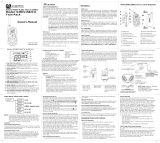 Bonso Electronics OVVGMRS1072 User manual
Bonso Electronics OVVGMRS1072 User manual
-
Audiovox GMRS1072CH Owner's manual
Other documents
-
Memorex MK1995 User manual
-
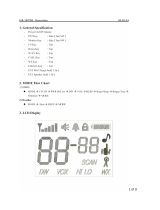 Genex Telecom PM3GR5000 User manual
Genex Telecom PM3GR5000 User manual
-
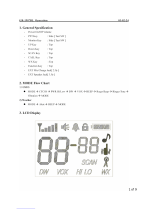 Genex Telecom GR-1907BL User manual
Genex Telecom GR-1907BL User manual
-
Kenwood KBP-5 Installation guide
-
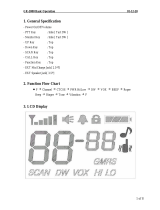 Genex GR-2000 User manual
Genex GR-2000 User manual
-
Columbia GMRS-1 User manual
-
Memorex MK-1700A User manual
-
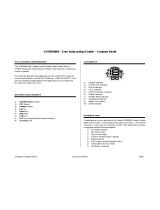 Trisquare Communications O9GGMRS480 User manual
Trisquare Communications O9GGMRS480 User manual
-
VTech V-Talk vt1311 User manual
-
Columbia GM22-SVP User manual
































